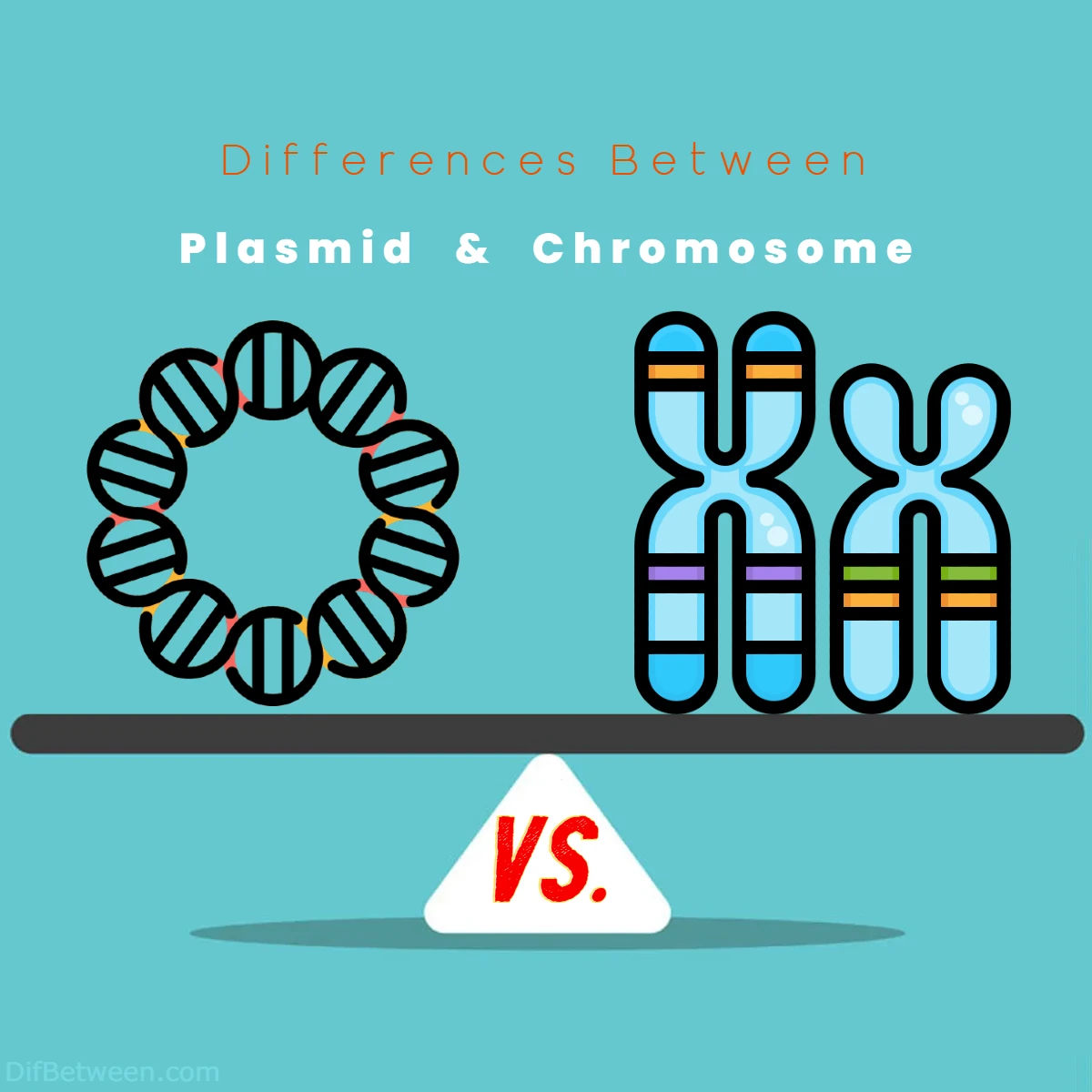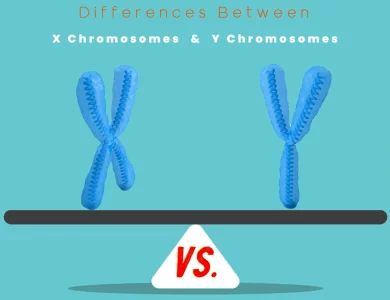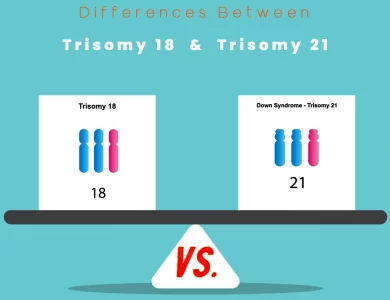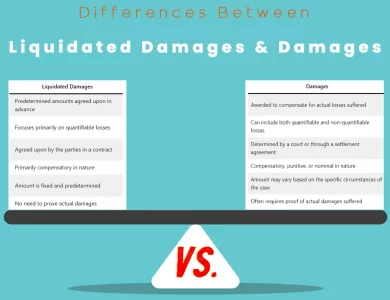
| Characteristic | Plasmids | Chromosomes |
|---|---|---|
| Structure | Small, circular DNA molecules | Larger, linear (in eukaryotes), and complex in structure |
| Number and Location | Variable in number, often in cytoplasm | Fixed number (per species) within the nucleus |
| Genetic Content | Non-essential genes, accessory traits | Core genes essential for cell/organism |
| Replication | Independent, relatively fast | Controlled, accurate, and occurs during the cell cycle |
| Inheritance and Evolution | Horizontal gene transfer, short-term evolution | Vertical inheritance, long-term evolution |
| Regulation and Control | Simplified regulation, responsive to cues | Complex regulation, central to cell/organism function |
| Significance in Microorganisms | Important for adaptability and survival of bacteria, including antibiotic resistance and virulence | Essential for basic cellular functions and survival in microorganisms |
| Role in Eukaryotic Organisms | Rare in eukaryotes, found in organelles like mitochondria and chloroplasts | Dominant genetic structure in the eukaryotic nucleus |
| Genetic Diversity and Adaptation | Facilitates rapid adaptation through horizontal gene transfer | Drives long-term evolutionary processes, leading to the diversification of species |
| Biotechnological and Therapeutic Implications | Valuable tools in biotechnology, widely used as vectors for gene transfer | Complex and challenging to manipulate, especially in eukaryotes |
| Importance in Biotechnology | Commonly used as vectors for genetic engineering | Used for genetic modifications in complex organisms |
| Therapeutic Applications | Limited therapeutic applications | Used in gene therapy and the correction of genetic disorders |
| Examples | Plasmids are common in bacteria and found in organelles of eukaryotic cells | Chromosomes are present in all organisms, including humans, animals, and plants |
Plasmids, those nimble, circular DNA molecules, act as dynamic accessories within a cell, carrying the secrets of antibiotic resistance, toxin production, and more. In contrast, chromosomes, like the master architects of an organism’s genetic blueprint, hold the core information essential for life’s intricate dance.
Differences Between Plasmid and Chromosome
The primary differences between Plasmid and Chromosome lie in their structure, number, and role within a cell. Plasmids are small, circular DNA molecules often carrying non-essential genes, while Chromosomes are larger, linear structures housing core genetic information necessary for an organism’s functioning. Plasmids are variable in number, independent, and play a pivotal role in short-term adaptation and the rapid spread of traits, notably antibiotic resistance in bacteria. In contrast, Chromosomes have a fixed number per species, are subject to complex regulation, and are integral to long-term evolution and the development of diverse species. Understanding these distinctions is crucial in comprehending the intricate world of genetics and molecular biology.
Structure and Composition
Plasmids: Plasmids are small, circular, double-stranded DNA molecules that exist independently within a cell. They are not part of the main chromosomal DNA and can be thought of as tiny, accessory genetic elements. Plasmids typically range in size from a few thousand to a few million base pairs, which is much smaller than the main chromosomal DNA.
Plasmids are relatively simple in structure compared to chromosomes. They lack the complex packaging and organization seen in chromosomes. Plasmids often carry genes that provide specific advantages to the cell, such as antibiotic resistance or the ability to metabolize certain compounds. These genes are known as “plasmid genes.”
Chromosomes: Chromosomes, on the other hand, are the large, thread-like structures found in the nucleus of eukaryotic cells. In prokaryotic cells like bacteria, chromosomes are also present but differ in structure from eukaryotic chromosomes. Eukaryotic chromosomes are linear, while prokaryotic chromosomes are typically circular.
Chromosomes are composed of chromatin, which is a combination of DNA and proteins (histones). This complex packaging of DNA into chromatin allows for efficient storage, organization, and regulation of the genetic material. The DNA in chromosomes contains all the genetic information needed for the proper functioning and development of an organism.
In summary, the primary structural difference between plasmids and chromosomes lies in their shape, size, and complexity. Plasmids are small, circular, and relatively simple, while chromosomes are larger, linear (in eukaryotes), and highly organized with associated proteins.
Number and Location
Plasmids: Cells can contain multiple plasmids, and the number of plasmids can vary from one cell to another. Plasmids are often found in the cytoplasm of the cell. They replicate independently and are not essential for the cell’s survival. Plasmids can be gained or lost by a cell without significant consequences.
Plasmids are commonly shared among bacterial cells through mechanisms like conjugation, where one cell transfers a plasmid to another. Plasmids can also be lost during cell division, making them less stable in comparison to chromosomes.
Chromosomes: In most organisms, cells have a fixed number of chromosomes. Humans, for example, have 46 chromosomes (23 pairs) in each of their somatic cells. These chromosomes are found in the nucleus of the cell. Chromosomes are vital for the cell’s survival, as they carry essential genetic information required for normal cell function and development.
Chromosomes are stably maintained within the cell, and their number is specific to each species. Changes in the number or structure of chromosomes can have severe consequences, including genetic disorders. Unlike plasmids, chromosomes are inherited from one generation to the next during cell division and are not as easily transferred between cells.
To summarize, plasmids are typically present in variable numbers within a cell and are less critical for the cell’s survival, while chromosomes are present in a fixed number and are essential for normal cellular function and development.
Genetic Content and Function
Plasmids: Plasmids often carry non-essential genes that provide selective advantages to the host cell under specific conditions. These genes can encode traits like antibiotic resistance, toxin production, or the ability to utilize unusual food sources. Plasmid genes are not required for basic cell functions and can be seen as optional extras that enhance the cell’s adaptability in challenging environments.
One remarkable aspect of plasmids is their ability to transfer horizontally between cells of the same or different species. This horizontal gene transfer allows for the rapid spread of advantageous traits, such as antibiotic resistance, among bacterial populations. Plasmids can also replicate independently of the chromosomal DNA, which contributes to their versatility.
Chromosomes: Chromosomes contain the core genetic information required for the normal functioning, growth, and development of the cell or organism. They carry genes responsible for essential functions, such as metabolism, cellular structure, and reproduction. Chromosomal genes are vital for the overall well-being of the organism.
Chromosomes are primarily inherited vertically, from one generation to the next, and their genetic content is relatively stable over time. Mutations or alterations in chromosomal genes can have profound effects on the organism’s traits and may be passed on to future generations.
In essence, plasmids are carriers of accessory genes that provide advantages in specific situations, while chromosomes house the fundamental genetic information necessary for an organism’s survival and growth.
Replication
Plasmids: Plasmids replicate independently of the chromosomal DNA. They have their own origin of replication, which is a specific sequence where DNA replication begins. Plasmid replication is relatively fast, and cells can have multiple copies of the same plasmid.
The process of plasmid replication is often less accurate than chromosomal replication, leading to a higher likelihood of mutations in plasmid DNA. This can be advantageous when a mutation confers a new function, such as antibiotic resistance, but it can also be detrimental.
Chromosomes: Chromosomal replication is tightly regulated and occurs during the cell cycle, specifically during the S phase in eukaryotic cells. The process is highly accurate and ensures that each daughter cell receives an identical copy of the chromosomal DNA.
Chromosomal replication is fundamental to the cell’s ability to divide and pass on its genetic material to the next generation. Mutations in chromosomal DNA can lead to genetic disorders and other serious consequences.
In summary, plasmids replicate independently and at a faster rate, which can be advantageous for the quick dissemination of beneficial traits. Chromosomal replication is a highly controlled and accurate process, essential for maintaining the genetic integrity of an organism.
Inheritance and Evolution
Plasmids: Plasmids can be transferred horizontally between cells, allowing genes from one cell to be acquired by another. This horizontal gene transfer is a significant factor in bacterial evolution and adaptation to changing environments. Plasmids can carry new traits that confer a selective advantage and, over time, become more prevalent in a bacterial population.
The rapid exchange of plasmids can also lead to the spread of antibiotic resistance genes among bacterial pathogens, which is a growing concern in healthcare.
Chromosomes: Chromosomes are primarily inherited vertically, from one generation to the next. The inheritance of chromosomal DNA ensures the continuity of an organism’s genetic information over generations. Changes in chromosomal genes, whether through mutation or recombination, can drive the evolutionary process, leading to the development of new species over long periods of time.
While chromosomal evolution occurs over extended time scales, it plays a pivotal role in the diversification and adaptation of species.
In essence, plasmids are key players in short-term bacterial evolution, allowing for rapid adaptation to changing conditions, while chromosomes are central to the long-term evolution and diversification of species.
Regulation and Control
Plasmids: Plasmids often carry genes that are under the control of specific regulatory elements. These regulatory elements determine when and to what extent the genes on the plasmid are expressed. This regulation allows the cell to activate or deactivate plasmid genes in response to environmental cues.
Plasmid gene regulation is critical for the cell’s ability to adapt to changing conditions. For example, a bacterium with a plasmid carrying antibiotic resistance genes may only activate those genes when exposed to antibiotics.
Chromosomes: Chromosomal genes are also subject to regulation, but the mechanisms and factors involved are more complex. The expression of chromosomal genes is tightly controlled and can be influenced by various internal and external factors. Chromosomal regulation is essential for the cell’s overall function, development, and response to environmental changes.
Chromosomal gene regulation plays a central role in the development of multicellular organisms, as it coordinates the differentiation of various cell types and ensures the proper functioning of the organism as a whole.
In summary, both plasmids and chromosomes undergo gene regulation, but the scale and complexity of regulation differ. Plasmid gene regulation is often more straightforward and responsive to specific environmental cues, while chromosomal gene regulation is integral to the development and functioning of complex organisms.
Significance in Microorganisms
Plasmids: Plasmids play a significant role in the adaptability and survival of microorganisms, especially bacteria. Many antibiotic resistance genes are carried on plasmids, enabling bacteria to resist the effects of antibiotics. Plasmids can be rapidly exchanged among bacterial populations, leading to the swift spread of antibiotic resistance, a major concern in healthcare settings.
Furthermore, plasmids can carry genes that allow bacteria to break down and utilize new food sources, which is crucial for their ecological niche. Plasmids also enable the production of toxins and other virulence factors, contributing to the pathogenicity of certain bacteria.
Chromosomes: Chromosomes in microorganisms, including bacteria, contain the core genes necessary for their basic cellular functions and survival. These genes are inherited vertically and are less subject to rapid changes than plasmid genes. Mutations in chromosomal genes can affect fundamental cellular processes, leading to alterations in the organism’s physiology or metabolism.
In microorganisms, the presence of specific genes on the chromosome is critical for their overall survival and functioning. Chromosomes provide the stability and genetic foundation for the microorganism’s existence.
Role in Eukaryotic Organisms
Plasmids: While plasmids are common in bacteria, they are relatively rare in eukaryotic organisms. In eukaryotes, plasmids are typically found in mitochondria and chloroplasts, which are believed to have evolved from ancient bacteria. These plasmids primarily contain genes related to the functions of these organelles, such as energy production in mitochondria.
Plasmids are not a characteristic feature of the eukaryotic nucleus, where the majority of the genetic material is contained within chromosomes. In eukaryotes, the nuclear chromosomes are responsible for encoding the traits, characteristics, and functions of the organism.
Chromosomes: Eukaryotic organisms, including plants, animals, and fungi, rely extensively on their chromosomes. The linear and highly organized chromosomes within the cell nucleus contain the genetic information that governs the development, physiology, and behavior of these complex organisms.
Chromosomes in eukaryotic organisms have distinctive structures and regions, including telomeres, centromeres, and various types of chromatin. These specialized features ensure proper replication, segregation, and regulation of the genes contained within the chromosomes.
In essence, plasmids are more relevant to eukaryotes in the context of organelles, while the eukaryotic nucleus is dominated by the extensive network of chromosomes.
Genetic Diversity and Adaptation
Plasmids: Plasmids are dynamic elements of genetic diversity in bacterial populations. They facilitate the acquisition of new traits and the adaptation of bacteria to changing environments. The ability of plasmids to transfer horizontally allows bacteria to rapidly share advantageous genes, leading to the evolution of new strains with enhanced capabilities.
Plasmids are central to the concept of “plasticity” in bacterial genomes, where they can gain or lose plasmids carrying specific genes as they encounter different selection pressures. This adaptability through plasmids is a critical aspect of bacterial evolution.
Chromosomes: While chromosomes are essential for the long-term evolution of species and the generation of genetic diversity, their changes occur at a slower pace. The genetic variation arising from chromosome mutations, recombinations, and gene shuffling can lead to the emergence of new species over extended periods of time.
Chromosomal evolution is the driving force behind the diversification of organisms and the development of complex life forms. It contributes to the gradual accumulation of genetic differences that ultimately define species.
In summary, plasmids are vital for short-term adaptation and rapid responses to environmental changes in bacterial populations, while chromosomes are the architects of long-term evolutionary processes shaping complex organisms.
Biotechnological and Therapeutic Implications
Plasmids: Plasmids are invaluable tools in biotechnology and genetic engineering. Researchers often use plasmids as vectors to introduce specific genes into bacterial or eukaryotic cells. This is a fundamental technique in the production of recombinant proteins, genetically modified organisms (GMOs), and gene therapy.
Plasmids carrying antibiotic resistance genes also have implications for public health. The spread of antibiotic resistance, facilitated by plasmids, has led to the development of novel antibiotic strategies and the need for responsible antibiotic use.
Chromosomes: Chromosomal manipulation in biotechnology and medicine is more complex and challenging than working with plasmids. Genetic modifications involving chromosomes are typically focused on eukaryotic organisms, including humans.
Chromosomal abnormalities and mutations are associated with genetic disorders, and therapies such as gene editing aim to correct these mutations at the chromosomal level. Techniques like CRISPR-Cas9 are used to target specific genes on chromosomes for modification.
In the realm of biotechnology, the manipulation of chromosomes in plants and animals can lead to the development of genetically modified crops and livestock.
Summary and Conclusion
Plasmids and chromosomes are distinct genetic entities that play crucial roles in the world of genetics and molecular biology. While plasmids are relatively simple, mobile, and quick to change, chromosomes are complex, stable, and central to the genetic integrity of organisms. These differences have far-reaching implications in fields such as microbiology, genetics, evolution, and biotechnology.
FAQs
Plasmids are small, circular, and independent DNA molecules often found in bacteria and other cells. They carry non-essential genes. Chromosomes, on the other hand, are larger, linear structures located in the nucleus of eukaryotic cells and carry essential genetic information for an organism.
Plasmids typically carry non-essential genes that provide specific advantages, such as antibiotic resistance. Chromosomes house core genetic information vital for an organism’s survival, development, and functioning.
A cell can have multiple plasmids, and their number can vary. In contrast, each species has a fixed number of chromosomes, and this number remains constant throughout the life of the organism.
Plasmids replicate independently, are fast, and have a higher likelihood of mutations. Chromosomal replication is tightly controlled, accurate, and occurs during the cell cycle.
Plasmids are essential for short-term adaptation and the rapid spread of advantageous traits. Chromosomes are central to long-term evolution, leading to the diversification of species over extended periods.
Plasmids are widely used in genetic engineering and gene transfer. Chromosomes, particularly in complex organisms, play a role in gene therapy and addressing genetic disorders.
Plasmids are significant for the adaptability and survival of microorganisms, particularly in terms of antibiotic resistance. Chromosomes contain essential genes for basic cellular functions in microorganisms.
Plasmids are commonly used as vectors for genetic engineering and are vital tools in biotechnology. Chromosomes are manipulated for genetic modifications in complex organisms, including humans.
Plasmids often have simplified regulation and are responsive to specific environmental cues. Chromosomes have complex regulation and are central to the functioning of cells and organisms.
Plasmids are common in bacteria and can be found in organelles like mitochondria. Chromosomes are present in all organisms, including humans, animals, and plants, serving as the primary genetic structures.
Read More:






